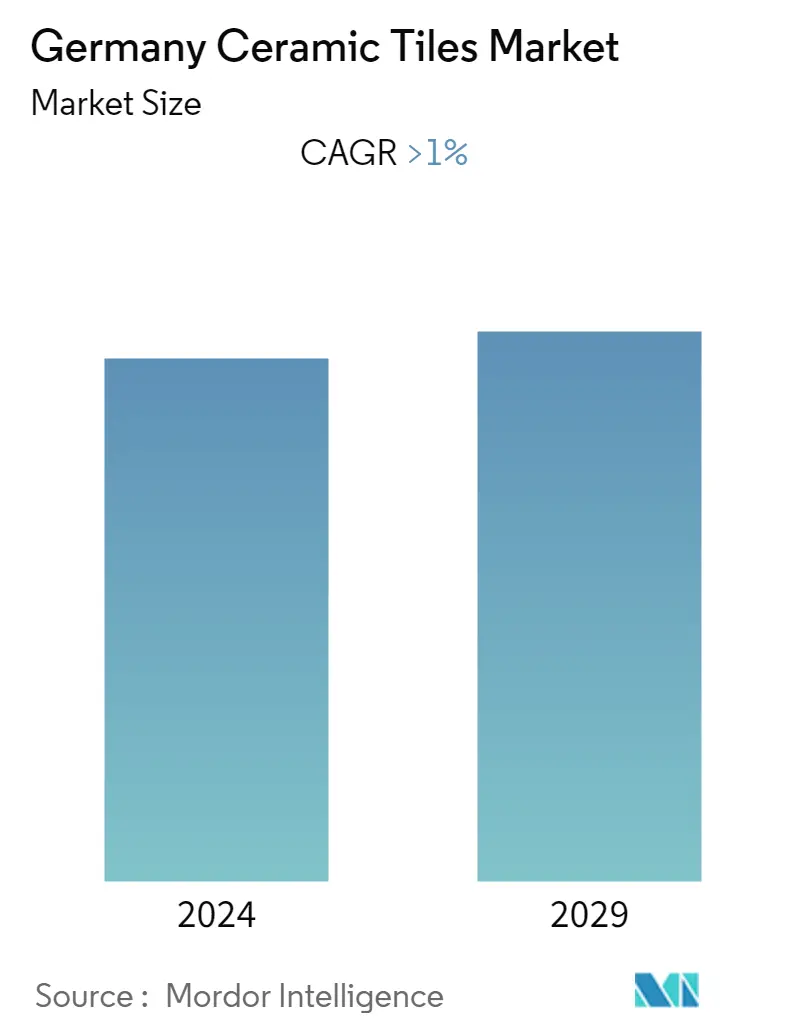Market Size of Germany Ceramic Tiles Industry

| Study Period | 2020 - 2029 |
| Base Year For Estimation | 2023 |
| Forecast Data Period | 2024 - 2029 |
| Historical Data Period | 2020 - 2022 |
| CAGR | > 1.00 % |
| Market Concentration | Low |
Major Players.webp)
*Disclaimer: Major Players sorted in no particular order |
Germany Ceramic Tiles Market Analysis
The global COVID-19 epidemic, the accompanying slowdown in economic activity, and the negative impact on production and demand caused significant challenges for manufacturers, particularly in the first and second quarters of 2020. Because international markets have, in certain cases, collapsed, ceramic tile imports have surged, and exports from German firms have declined dramatically.
Germany is one of the European region's major markets for ceramic tiles. The country has the benefits of highly developed and most advanced ceramic products like roof tiles, bricks, sanitary ware, etc. The significant consumer expenditure on residential and housing construction is another factor that benefits the market growth. The booming prospects of the construction sector are attributed to state investments and low-interest rates. The rising demand for new residential infrastructures is the principal factor influencing the German ceramic tiles market growth. Germany is one of the significant producers of kaolin in the European region.
In Germany, the ceramic tile market has grown similarly. Imports of tiles in 2020 climbed by 9.8%, totaling 113.6 million square meters. According to statistics, average import prices range from 4.00 to 13.85 euros per square meter. Frequently, a larger volume was purchased at a lower price. Italy's imports remain stable at roughly 60.2 million square meters, followed by Turkey (14.7 million square meters), Spain (11.2 million square meters), Poland (11.2 million square meters), and the Czech Republic (7.5 million square meters). The increased imports can be explained by the fact that after their home market collapsed, manufacturers in other countries shifted to the stable German market. At the same time, this shift means that German manufacturers, who export around a third of their products, have lost a significant export market in some situations.
Germany Ceramic Tiles Industry Segmentation
A complete background analysis of the Germany Ceramic Tiles Market, which includes an assessment of the National accounts, economy, and emerging market trends by segments, significant changes in the market dynamics, and the market overview, is covered in the report. German Ceramic Tiles Market is segmented by Product (Glazed, Porcelain, Scratch Free, Other Products), Application (Floor Tiles, Wall Tiles, Other Applications), Construction Type (New Construction, Replacement, and Renovation), and End User (Residential, and Commercial).
| Product | |
| Glazed | |
| Porcelain | |
| Scratch Free | |
| Others |
| Application | |
| Floor Tiles | |
| Wall Tiles | |
| Other Tiles |
| Construction Type | |
| New Construction | |
| Replacement and Renovation |
| End User | |
| Residential | |
| Commercial |
Germany Ceramic Tiles Market Size Summary
The German ceramic tiles market is a significant player in the European region, benefiting from advanced ceramic product offerings and substantial consumer spending on residential and housing construction. The market's growth is driven by the booming construction sector, supported by state investments and low-interest rates, which have spurred demand for new residential infrastructures. Germany's position as a major producer of kaolin further enhances its market standing. Despite challenges posed by the global COVID-19 pandemic, which led to increased imports and a decline in exports, the market has shown resilience. The demand for ceramic tiles is expected to accelerate, fueled by rapid industrialization and urbanization, which have led to increased construction activities across residential, commercial, and industrial sectors.
The market is characterized by a high adoption rate of ceramic tiles in interior construction, with floor tiles generating significant revenue. The durability, cost-effectiveness, and eco-friendly properties of ceramic tiles make them a preferred choice in various sectors, including healthcare and institutional buildings. The presence of major international players and the entry of mid-size to smaller companies, driven by technological advancements and product innovation, are shaping the competitive landscape. Recent developments, such as RAK Ceramics' acquisition of Kludi Group and Alois Korzilius Interbau's new finishing technique, highlight the ongoing efforts to expand operations and enhance product offerings in the German ceramic tiles market.
Germany Ceramic Tiles Market Size - Table of Contents
-
1. MARKET DYNAMICS
-
1.1 Market Overview
-
1.2 Market Drivers
-
1.3 Market Restraints
-
1.4 Value Chain / Supply Chain Analysis
-
1.5 Porter's Five Forces Analysis
-
1.5.1 Threat of New Entrants
-
1.5.2 Bargaining Power of Buyers/Consumers
-
1.5.3 Bargaining Power of Suppliers
-
1.5.4 Threat of Substitute Products
-
1.5.5 Intensity of Competitive Rivalry
-
-
1.6 Insights on Technological Trends in the Industry
-
1.7 Impact of COVID-19 on the Market
-
-
2. MARKET SEGMENTATION
-
2.1 Product
-
2.1.1 Glazed
-
2.1.2 Porcelain
-
2.1.3 Scratch Free
-
2.1.4 Others
-
-
2.2 Application
-
2.2.1 Floor Tiles
-
2.2.2 Wall Tiles
-
2.2.3 Other Tiles
-
-
2.3 Construction Type
-
2.3.1 New Construction
-
2.3.2 Replacement and Renovation
-
-
2.4 End User
-
2.4.1 Residential
-
2.4.2 Commercial
-
-
Germany Ceramic Tiles Market Size FAQs
What is the current Germany Ceramic Tiles Market size?
The Germany Ceramic Tiles Market is projected to register a CAGR of greater than 1% during the forecast period (2024-2029)
Who are the key players in Germany Ceramic Tiles Market?
Villeroy & Boch, Agrob Buchtal, Argelith Ceramic, Porcelaingres GmbH and Refratechnik Ceramics GmbH are the major companies operating in the Germany Ceramic Tiles Market.

